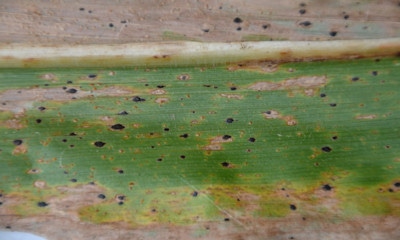
Several old enemies, along with a few new adversaries, kept the University of Illinois Plant Clinic busy in 2015. According to Suzanne Bissonnette, Interim Extension ANR program leader & Plant Clinic director, the clinic studied 3,522 unique samples last year. The clinic reviews samples from field crop plants, soils, vegetables, forages and more. The team helps identify problems ranging from insects, weeds and chemical injuries to disease diagnoses.
The final tally in 2015: 5,431 diagnoses
What did the diagnostic team find in corn in soybean fields last year? Bissonnette shares the top five findings, along with a few surprises.

Characteristic black fruiting structures of a new fungal leaf disease called ‘Tar spot’, found in Illinois and Indiana fall 2015. (Photo: University of Illinois Extension Commercial Agriculture Educator Russ Higgins.
Related: 'Tar spot' corn leaf fungus identified in 3 Illinois counties
In soybeans, they identified: frogeye leaf spot, Cercospora blight, Septoria brown spot, herbicide carryover injury and soybean vein necrosis virus.
Soybean rust was identified in Champaign County. Bissonnette says it is highly unlikely one county alone was hit by rust, but it was only identified in one field. She recommends farmers and agronomists keep an eye on fields mid to late season this year. Soybean rust is difficult to identify, but it’s imperative to stay ahead of it. Soybean rust can cause significant yield reductions.
In cornfields, the top five foes were: Northern corn leaf blight, gray leaf spot, anthracnose, southern rust and common rust.
New pests discovered
“Lots and lots happened with regard to corn this year. If you’re a plant pathologist, we like fungi,” says Bissonnette. “In September, we had a number of new pests show up in Illinois.”
The first discovery was tar spot. This disease, appearing as a speck of tar on leaves, is not only new to Illinois, it’s new to the United States. The bumpy features of tar spot were found late enough in the year that yield loss wasn’t a concern. Bissonnette says this fungus, which thrives in cooler temperatures and high humidity, likely came from a strong tropical storm from the south.
Tar spot alone may not cause yield reduction. However, when tar spot is followed by another fungus, Monographella maydis, it creates “fish eye” lesions on the plant. The ‘fish eye’ lesion is dead plant tissue, surrounding the tar spot, creating “tar spot complex”. University of Illinois Plant Pathologists and Agronomists are working on a survival study to see if tar spot can overwinter, potentially staying in the Midwest for good.
Related: Learn more about tar spot in corn
The second disease making its debut appearance in Illinois cornfields: bacterial stripe. Easily mistaken for Goss’ Wilt or Stewards Wilt, identifying bacterial stripe is challenging. Bissonnette says yield loss potential is not a major concern, but she is worried about how widespread this disease was in 2015.
Bissonnette says to keep a close eye on fields this year and send in samples when identification is a problem. She notes a year like 2015 leaves her a little uneasy. “When is the last time a new disease showed up on corn? It’s been forever. So I do have some concerns when we’re starting to see these things.”
About the Author(s)
You May Also Like




